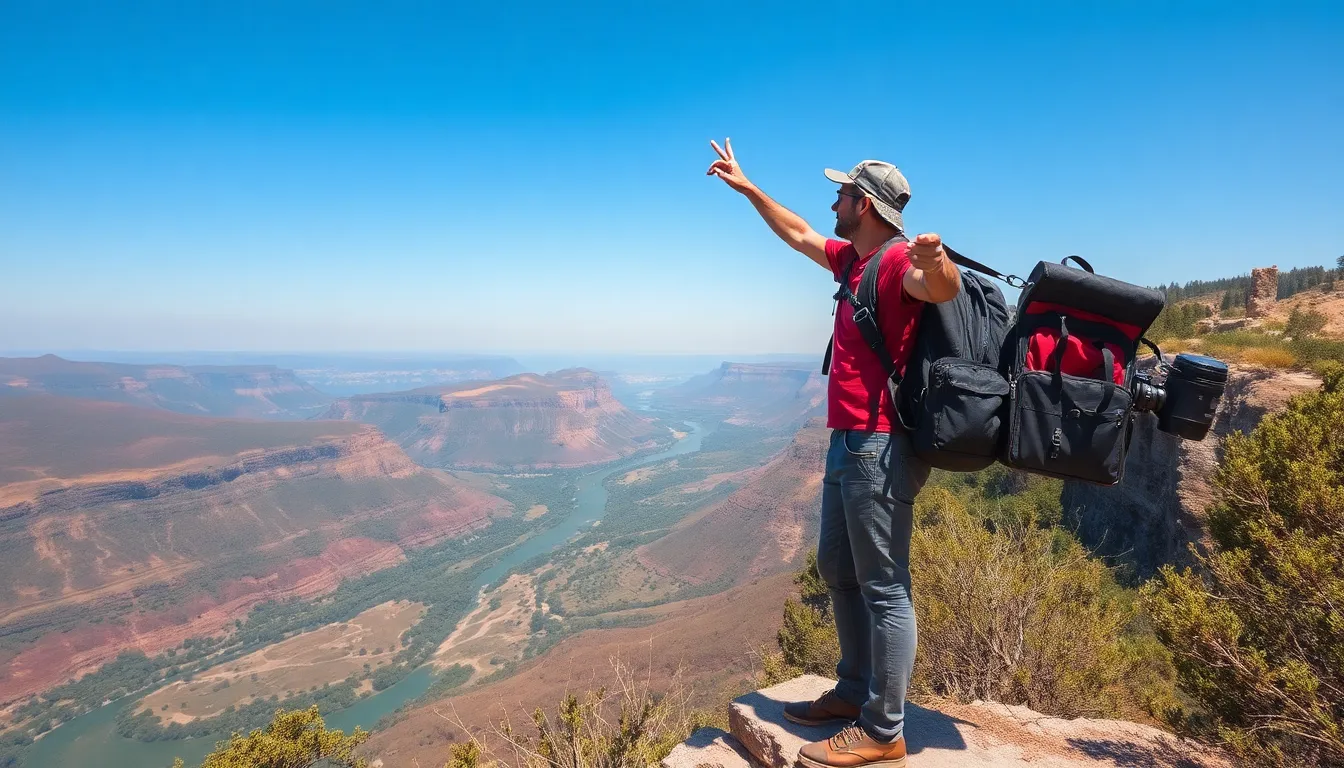Traveling opens the door to breathtaking landscapes and vibrant cultures, but capturing those moments can feel like a daunting task. Fear not! With the right travel photography tips, anyone can transform their snapshots from “meh” to “wow!” Imagine your friends scrolling through Instagram, gasping at your stunning shots while you sip a piña colada on the beach.
Table of Contents
ToggleEssential Travel Photography Tips
Travel photography captures stunning moments and places, enhancing any trip. Following specific tips elevates images from simple snapshots to impressive art.
Research Your Destination
Researching the destination fosters better photography results. Understanding local culture and popular landmarks helps identify key photo opportunities. Utilizing travel blogs and photography sites reveals iconic spots and less-known gems. Maps and local guides assist in planning the best shots at optimal times. Having an awareness of weather patterns aids in selecting the right gear and clothing for photographic excursions. Knowing the customs can prevent unwanted interruptions during photoshoots. Use resources like Instagram and Pinterest for visual inspiration, focusing on unique angles or themes.
Know Your Gear
Familiarity with photography gear enhances the shooting experience. Understanding camera settings like ISO, aperture, and shutter speed empowers better control over images. Carry essential accessories such as extra batteries and memory cards to avoid missing moments. Prioritizing lightweight lenses makes transporting gear easier during long trips. Practicing various techniques in advance boosts confidence and creative results in the field. Checking equipment before leaving ensures everything is functional, reducing stress during shoots. Use a tripod when necessary for stability, especially in low-light conditions or landscapes.
Composition Techniques

Composition plays a vital role in creating captivating travel photos. It guides the viewer’s eye and enhances storytelling through imagery.
Rule of Thirds
The Rule of Thirds divides an image into nine equal sections using two horizontal and two vertical lines. Photographers should place key elements along these lines or at their intersections to create balanced images. It draws attention to the focal point and encourages a natural flow. For example, positioning a subject off-center results in a more dynamic photograph. Many photographers find this technique effective for landscapes, portraits, and street scenes. Experimenting with this composition can elevate ordinary shots into engaging visuals.
Leading Lines
Leading lines direct the viewer’s gaze through the photograph, guiding them toward the main subject. Roads, rivers, and architectural elements serve as excellent examples of natural lines. Incorporating these lines into a composition establishes depth and context. Photographers can enhance their images by using paths or fences that lead to a horizon or distant landmark. This technique creates a sense of movement and invites exploration. By using leading lines, travelers can transform static images into immersive experiences.
Mastering Lighting Conditions
Utilizing the right lighting transforms travel photos significantly. Mastering lighting conditions allows photographers to enhance their images and capture vibrant details.
Golden Hour Photography
Golden hour occurs shortly after sunrise and just before sunset. Soft, warm light enhances colors, creating dreamy effects. Photographers often take advantage of this time for stunning landscapes and portraits. Angling the camera toward the horizon can capture spectacular sky colors. Also, shooting with the sun behind the subject creates beautiful silhouettes. Preparing for golden hour is essential, as light changes quickly. Knowing the sunrise and sunset times helps photographers plan their shoots effectively.
Night Photography Tips
Capturing images at night presents unique challenges. Using a tripod becomes essential to avoid blurriness from slow shutter speeds. Setting a higher ISO allows cameras to absorb more light, brightening the images. Experimenting with longer exposure times can reveal stunning light trails from city streets or stars in the night sky. Focusing on well-lit subjects enhances contrast against dark backgrounds. Understanding how to use manual settings improves control over brightness and clarity. Lastly, incorporating artificial light sources, such as street lamps or neon signs, adds an artistic touch to night shots.
Capturing Local Culture
Capturing local culture enhances travel photography, transforming images into stories. Each photograph reflects the unique identity of a destination.
Respecting Traditions
Respecting traditions is crucial when documenting cultural practices. Observing rituals, festivals, or ceremonies allows photographers to capture authentic moments. Before snapping photos, asking for permission shows consideration for local customs. Understanding cultural significance adds depth to images, making them resonant and powerful. When photographing people, highlighting their attire or crafts can showcase traditional artistry. Many travelers find that vibrant markets are perfect for showing daily life. Engaging with these settings helps illuminate the essence of local traditions.
Engaging with Locals
Engaging with locals provides opportunities for intimate and candid photography. Creating connections often leads to unique encounters and insights into daily life. Approaching residents with genuine curiosity invites them to share their stories. Photographers frequently discover hidden gems through local recommendations. Portraits taken with permission reflect not just faces but also individual narratives and community identity. Sharing photographs afterward can strengthen relationships and cultivate goodwill. Many cultures appreciate when visitors take time to learn about their way of life, making it easier to capture compelling images.
Post-Processing Strategies
Post-processing is essential for refining travel photos and achieving stunning results. Applying the right techniques can transform images, bringing them to life and enhancing their visual appeal.
Editing Software Suggestions
Numerous editing software options are available for various skill levels. Adobe Lightroom offers powerful tools for both beginners and professionals, specializing in organizing and enhancing photos. For those seeking user-friendly alternatives, Snapseed provides intuitive editing features on mobile devices. Capture One excels at color grading and raw file processing, catering to serious photographers. Additionally, GIMP serves as a free option with a robust set of editing capabilities. Selecting the right software can significantly improve editing efficiency and outcomes.
Enhancing Your Photos
Enhancing photos involves adjusting several key elements. First, tweaking exposure helps balance light and shadow, creating more vibrant images. Adjusting contrast enhances details, adding depth and richness. After that, refining saturation and vibrance can make colors pop without overwhelming the composition. Applying sharpening techniques clarifies details, ensuring the main subject stands out. Lastly, utilizing cropping to remove distractions directs focus to the subject, elevating overall impact. Each step plays a crucial role in maximizing the potential of travel photos.
Travel photography is more than just taking pictures; it’s about telling stories and capturing the essence of experiences. By applying the tips shared, photographers can elevate their skills and create images that resonate with viewers. Understanding the importance of composition lighting and cultural engagement adds depth to each shot.
Post-processing also plays a vital role in refining photos and bringing out their full potential. With practice and creativity, anyone can transform their travel memories into stunning visual narratives. Embracing these techniques not only enhances photography but also enriches the overall travel experience, making every moment unforgettable.


